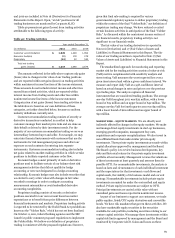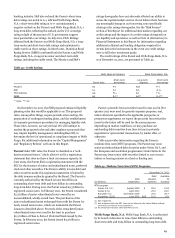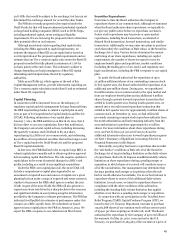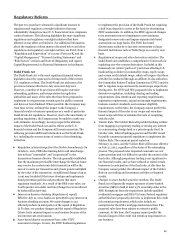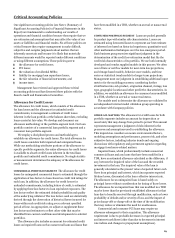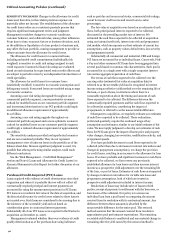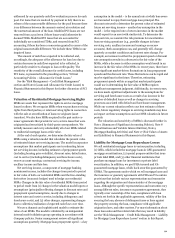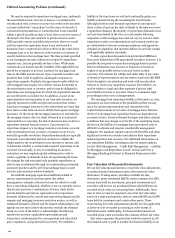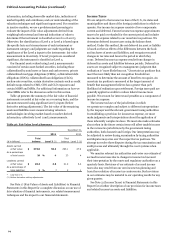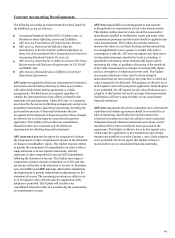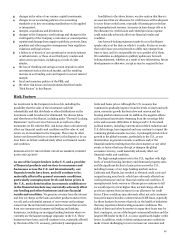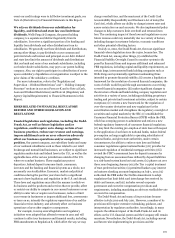Wells Fargo 2011 Annual Report Download - page 93
Download and view the complete annual report
Please find page 93 of the 2011 Wells Fargo annual report below. You can navigate through the pages in the report by either clicking on the pages listed below, or by using the keyword search tool below to find specific information within the annual report.addressed by our quarterly cash flow evaluation process for each
pool. For loans that are resolved by payment in full, there is no
release of the nonaccretable difference for the pool because there
is no difference between the amount received at resolution and
the contractual amount of the loan. Modified PCI loans are not
removed from a pool even if those loans would otherwise be
deemed TDRs. Modified PCI loans that are accounted for
individually are considered TDRs, and removed from PCI
accounting if there has been a concession granted in excess of the
original nonaccretable difference. We include these TDRs in our
impaired loans.
The amount of cash flows expected to be collected and,
accordingly, the adequacy of the allowance for loan loss due to
certain decreases in cash flows expected to be collected, is
particularly sensitive to changes in loan credit quality. The
sensitivity of the overall allowance for credit losses, including
PCI loans, is presented in the preceding section, “Critical
Accounting Policies – Allowance for Credit Losses.”
See the “Risk Management – Credit Risk Management”
section and Note 6 (Loans and Allowance for Credit Losses) to
Financial Statements in this Report for further discussion of PCI
loans.
Valuation of Residential Mortgage Servicing Rights
MSRs are assets that represent the rights to service mortgage
loans for others. We recognize MSRs when we purchase servicing
rights from third parties, or retain servicing rights in connection
with the sale or securitization of loans we originate (asset
transfers). We also have MSRs acquired in the past under co-
issuer agreements that provide for us to service loans that were
originated and securitized by third-party correspondents. We
initially measure and carry substantially all of our MSRs related
to residential mortgage loans at fair value.
At the end of each quarter, we determine the fair value of
MSRs using a valuation model that calculates the present value
of estimated future net servicing income. The model incorporates
assumptions that market participants use in estimating future
net servicing income, including estimates of prepayment speeds
(including housing price volatility), discount rates, default rates,
cost to service (including delinquency and foreclosure costs),
escrow account earnings, contractual servicing fee income,
ancillary income and late fees.
Net servicing income, a component of mortgage banking
noninterest income, includes the changes from period to period
in fair value of both our residential MSRs and the free-standing
derivatives (economic hedges) used to hedge our residential
MSRs. Changes in the fair value of residential MSRs from period
to period result from (1) changes in the valuation model inputs or
assumptions (principally reflecting changes in discount rates and
prepayment speed assumptions, mostly due to changes in
interest rates and costs to service, including delinquency and
foreclosure costs), and (2) other changes, representing changes
due to collection/realization of expected cash flows over time.
We use a dynamic and sophisticated model to estimate the
value of our MSRs. The model is validated by an independent
internal model validation group operating in accordance with
Company policies. Senior management reviews all significant
assumptions quarterly. Mortgage loan prepayment speed – a key
assumption in the model – is the annual rate at which borrowers
are forecasted to repay their mortgage loan principal. The
discount rate used to determine the present value of estimated
future net servicing income – another key assumption in the
model – is the required rate of return investors in the market
would expect for an asset with similar risk. To determine the
discount rate, we consider the risk premium for uncertainties
from servicing operations (e.g., possible changes in future
servicing costs, ancillary income and earnings on escrow
accounts). Both assumptions can, and generally will, change
quarterly as market conditions and interest rates change. For
example, an increase in either the prepayment speed or discount
rate assumption results in a decrease in the fair value of the
MSRs, while a decrease in either assumption would result in an
increase in the fair value of the MSRs. In recent years, there have
been significant market-driven fluctuations in loan prepayment
speeds and the discount rate. These fluctuations can be rapid and
may be significant in the future. Therefore, estimating
prepayment speeds within a range that market participants
would use in determining the fair value of MSRs requires
significant management judgment. Additionally, in recent years,
we have made significant adjustments to the assumptions for
servicing and foreclosure costs as a result of an increase in the
number of defaulted loans as well as changes in servicing
processes associated with default and foreclosure management.
While our current valuation reflects our best estimate of these
costs, future regulatory changes in servicing standards may have
an impact on these assumptions and our MSR valuation in future
periods.
The valuation and sensitivity of MSRs is discussed further in
Note 1 (Summary of Significant Accounting Policies), Note 8
(Securitizations and Variable Interest Entities), Note 9
(Mortgage Banking Activities) and Note 17 (Fair Values of Assets
and Liabilities) to Financial Statements in this Report.
Liability for Mortgage Loan Repurchase Losses
We sell residential mortgage loans to various parties, including
(1) GSEs, which include the mortgage loans in GSE-guaranteed
mortgage securitizations, (2) special purpose entities that issue
private label MBS, and (3) other financial institutions that
purchase mortgage loans for investment or private label
securitization. In addition, we pool FHA-insured and VA-
guaranteed mortgage loans, which back securities guaranteed by
GNMA. The agreements under which we sell mortgage loans and
the insurance or guaranty agreements with FHA and VA contain
provisions that include various representations and warranties
regarding the origination and characteristics of the mortgage
loans. Although the specific representations and warranties vary
among different sales, insurance or guarantee agreements, they
typically cover ownership of the loan, compliance with loan
criteria set forth in the applicable agreement, validity of the lien
securing the loan, absence of delinquent taxes or liens against
the property securing the loan, compliance with applicable
origination laws, and other matters. For more information about
these loan sales and the related risks that may result in liability
see the “Risk Management – Credit Risk Management – Liability
for Mortgage Loan Repurchase Losses” section in this Report.
91


